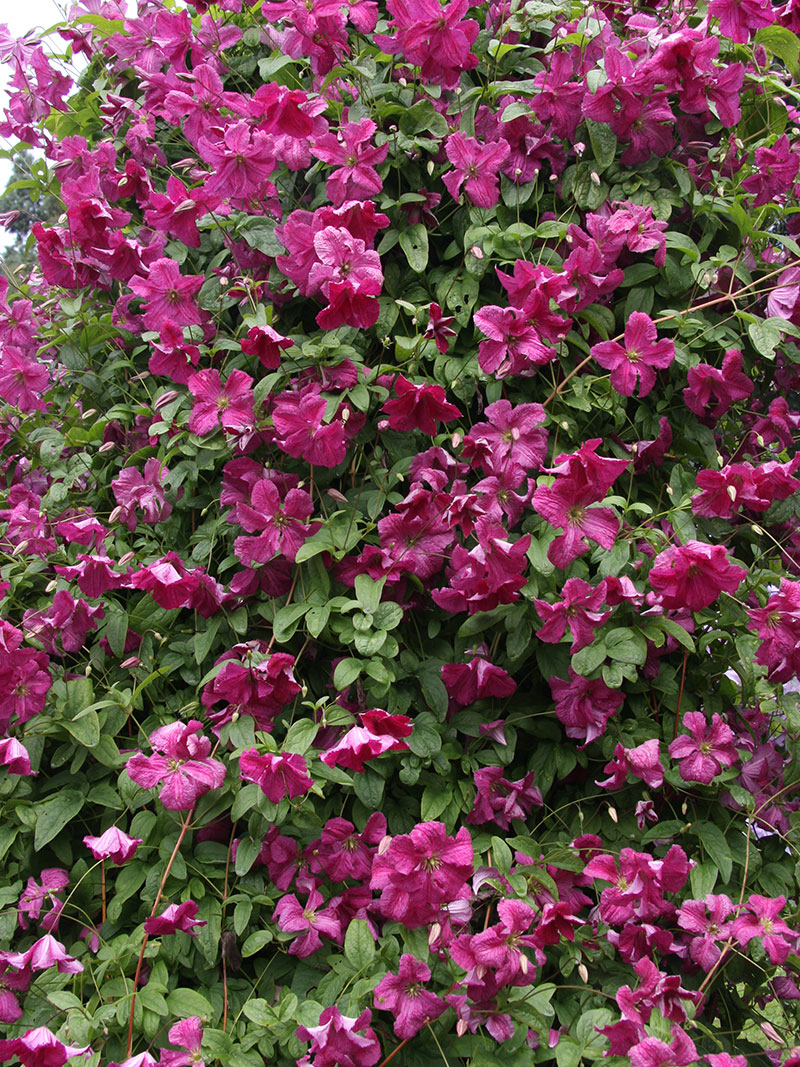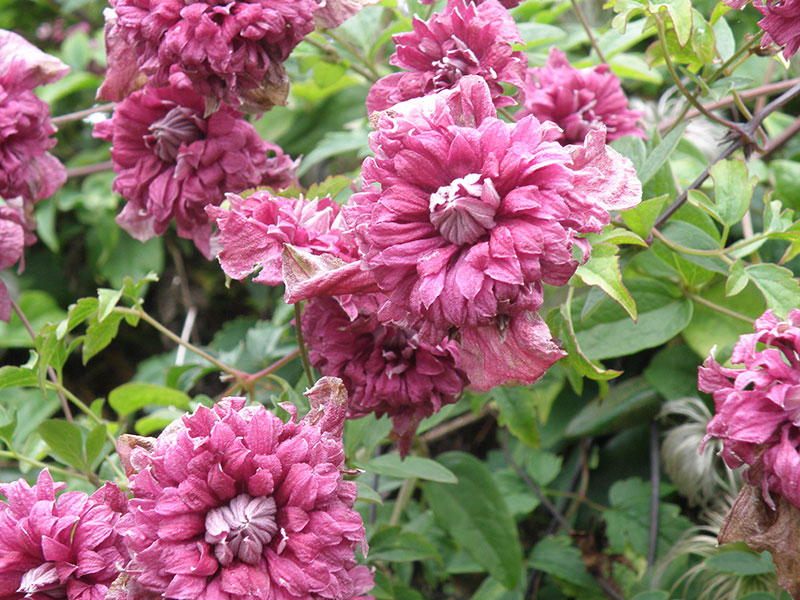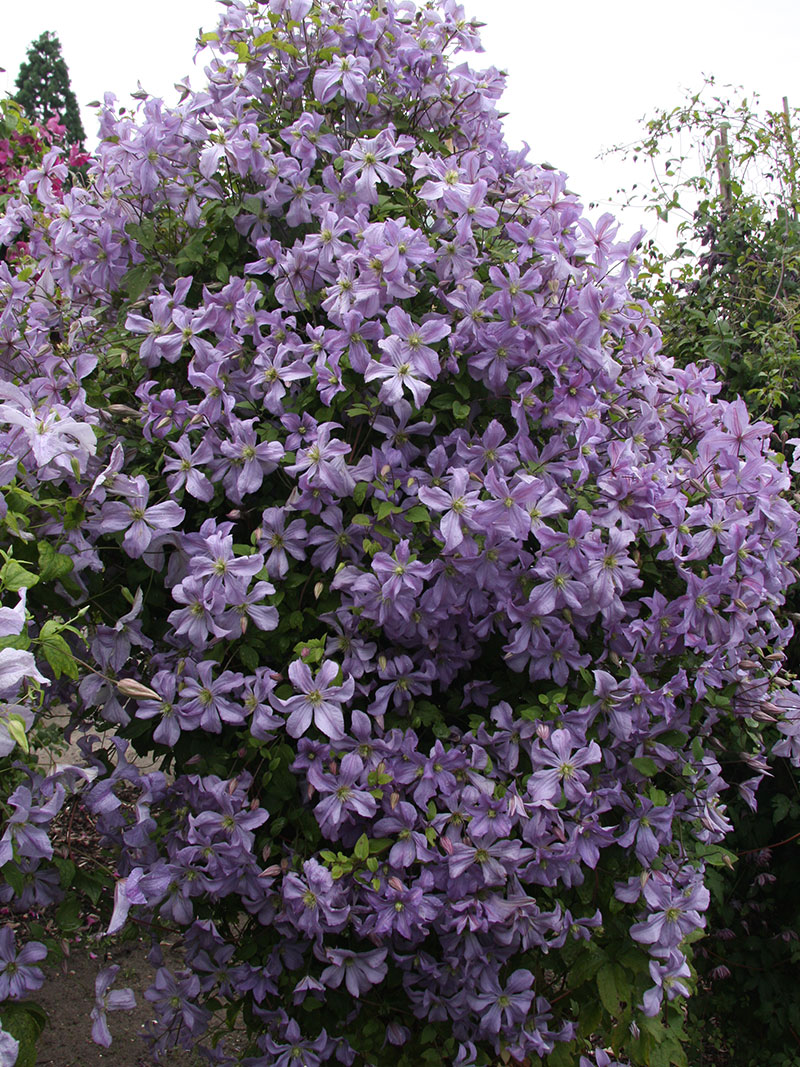Viticella
Growing clematis from the viticella group
Introduction
Clematis viticella is a European and West Asian species good at climbing and scrambling, robust, hardy and drought-tolerant. It makes an easy-to-grow and reliable garden plant. The colour range now is from deep rich reds and purples through pastel blues and pinks to white. The sizes range between 2m and 3m. All have flowers that hang downwards.
Planting
These clematis are not at all fussy as to soil type, but by giving them a good start in life you will be well rewarded, so choose a site that is not shaded from above (stand on the spot and look up: if you can see sky it’s OK). On the shady side of a building or fence is fine, but not under a dense tree canopy. If the plant is to grow over or through other plants of the Viticella group, plant it on the northern outside edge and lean it in.
Dig a hole at least twice the depth and width of the pot so that good compost and fertiliser can be added to the planting hole. Ensure that the hole and plant are well watered before planting at soil level or five or six cm deeper than this.
Putting a tube next to the plant at planting time will save you both time and water by ensuring water reaches the roots without getting hijacked by any existing plants. Watering well in the first growing season is the key to success. It is best to supply large amounts intermittently rather than a dribble every day. Next to buildings and walls can be especially dry spots. The good news is that once established the root systems will cope even in dryish spots and find their own water.
Do remember that these are climbing plants and need something they can get hold of to climb on.
Pruning and aftercare
Pruning a viticella couldn't be simpler. In late February or early March prune to about 50cm from the ground or pot level. In very mild areas this can be carried out from November onwards. Pruning hard encourages the plant to make more stems and therefore more flowers. This will also retain the plant in its flowering position without becoming too tall.
Slug and snail attack on the newly emerging shoots in spring can be a problem in the early years after planting. Use whatever method you like to control them. Over time this may become less of a problem.
Growing in containers
Viticella can be grown successfully in containers but always remember if the plant is in a container, it’s up to you to keep it on life support. You may go for a modest-sized container (10–15lt) and repot every couple of years. If the plant has become root-bound, reduce it in the dormant season by about one third and repot with fresh compost. In larger containers remove some of the topsoil and replace with fresh compost every couple of years. Good drainage is essential as viticella will not thrive in waterlogged conditions. Cover drainage holes with crocks and put the container on small bricks or supports so that the bottom is off the ground. Keep the pot as cool as possible and, if the container is to be placed in a south-facing position, line it with bubble wrap before filling with compost to protect the roots from overheating. If the plant is placed in a very large container, such as a half-barrel, it will be happy for many years. In all cases, feeding and regular watering will help the plant to thrive; adding soil to the compost mix may also be useful.
Feeding
Something slow-acting seems best, such as bone meal or a blood, fish and bone mixture in autumn or spring. If you have dogs or wildlife wanting to dig up the fertiliser you may find something inorganic more appropriate. Liquid feeds high in potash are ideal for containers. Using half the recommended strength fortnightly during the growing season is ideal, or else watering weekly on an alternative basis.
Propagation
The easiest method for producing a small number of new plants is to layer stems in the autumn (rather than cutting them off) or, in the case of a well-established clump, simply split it with a spade. You can also try using the thicker portions of stems cut down in winter to make hard-wood cuttings: 20–30cm long with two leaf nodes seems to work, and a hormone rooting substance will help. These are best then placed in a cold frame or similar. The percentage which root will be low but as it was waste prunings you were throwing away anyway it is something for nothing.
Nurseries will mostly take softwood or semi-ripe internodal cuttings about 2–3 cm long and root them in humid conditions with bottom heat between April and June.
Some suggested plants
Reds Kermesina, Carmencita, Madam Julia Correvon, Södertälje
Pinks Hagelby, Entel, Pink Carlien
Purples Étoile Violette, Little Bas, Poldice
Whites Alba Luxurians, Kathryn Chapman, Hagelby White
Blues Morning Heaven, Lavender Twirl
Bi-colours Minuet, I am Lady Q
For scent Betty Corning, Triternata rubromarginata







